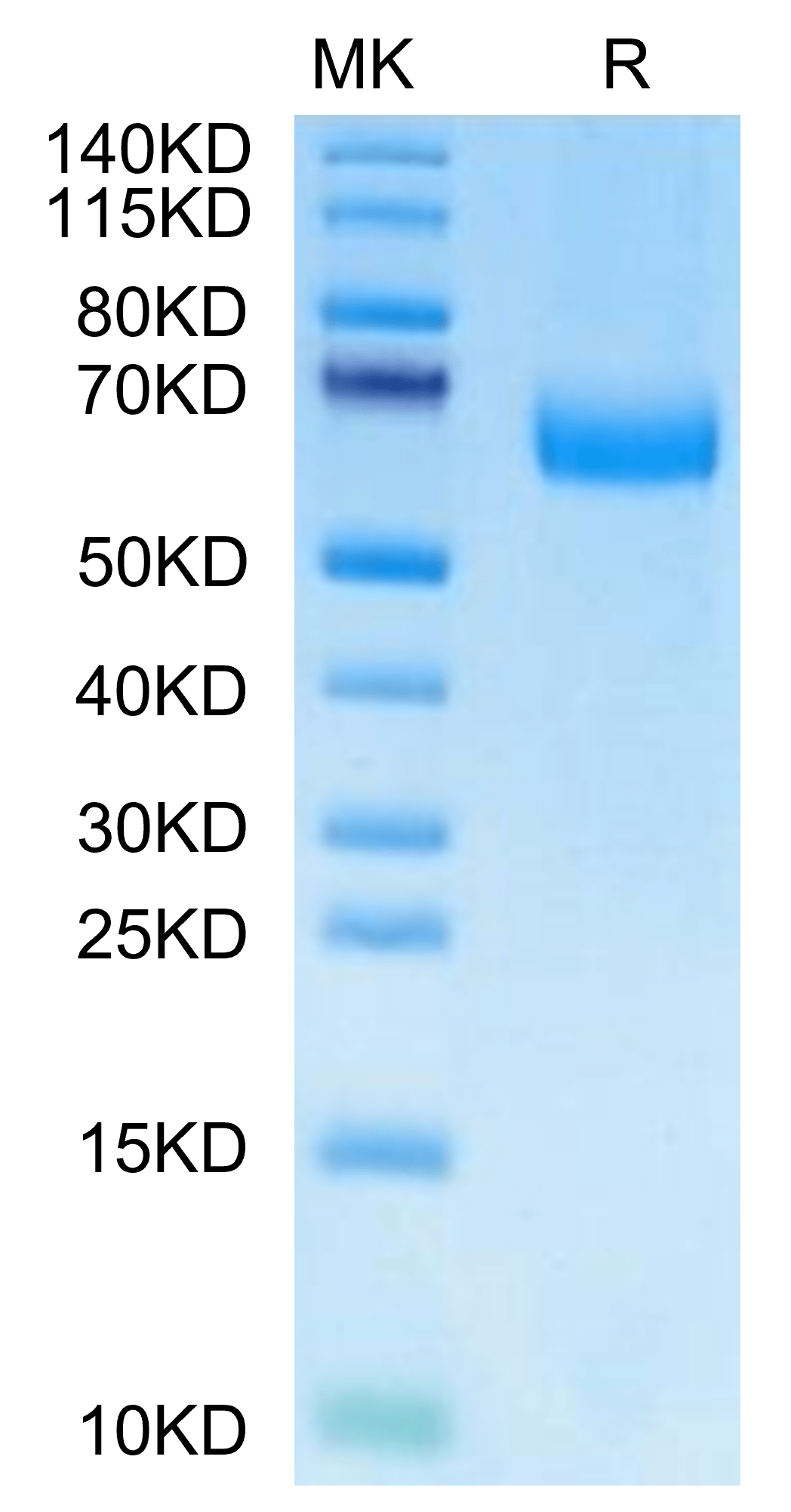| Weight | 1 lbs |
|---|---|
| Dimensions | 9 × 5 × 2 in |
| accession | NP_001074551 |
| express system | HEK293 |
| product tag | C-His |
| purity | > 95% as determined by Tris-Bis PAGE |
| background | Alkaline phosphatase can be considered "our favorite enzyme" for reasons apparent to those who diagnose and treat metabolic bone diseases or who study skeletal biology. Few might know, however, that alkaline phosphatase likely represents the most frequently assayed enzyme in all of medicine. Elevated activity in the circulation is universally recognized as a marker for skeletal or hepatobiliary disease. |
| molecular weight | The protein has a predicted MW of 53.10 kDa. Due to glycosylation, the protein migrates to 60-70 kDa based on Tris-Bis PAGE result. |
| available size | 100 µg, 500 µg |
| endotoxin | Less than 1EU per μg by the LAL method. |
Mouse Alkaline phosphatase (Intestinal type) /ALPI Protein 2976
$315.00 – $1,050.00
Summary
- Expression: HEK293
- Pure: Yes (SDS-PAGE)
- Amino Acid Range: Ile21-Gly501
Mouse Alkaline phosphatase (Intestinal type) /ALPI Protein 2976
| protein |
|---|
| Size and concentration 100, 500µg and lyophilized |
| Form Lyophilized |
| Storage Instructions Valid for 12 months from date of receipt when stored at -80°C. Recommend to aliquot the protein into smaller quantities for optimal storage. Please minimize freeze-thaw cycles. |
| Storage buffer Shipped at ambient temperature. |
| Purity > 95% as determined by Tris-Bis PAGE |
| target relevance |
|---|
| Alkaline phosphatase can be considered "our favorite enzyme" for reasons apparent to those who diagnose and treat metabolic bone diseases or who study skeletal biology. Few might know, however, that alkaline phosphatase likely represents the most frequently assayed enzyme in all of medicine. Elevated activity in the circulation is universally recognized as a marker for skeletal or hepatobiliary disease. |
| Protein names Intestinal-type alkaline phosphatase (IAP) (Intestinal alkaline phosphatase) (EC 3.1.3.1) |
| Gene names ALPI,ALPI |
| Protein family Alkaline phosphatase family |
| Mass 9606Da |
| Function Alkaline phosphatase that can hydrolyze various phosphate compounds. |
| Catalytic activity BINDING 61; /ligand="Mg(2+)"; /ligand_id="ChEBI:CHEBI:18420"; /evidence="ECO:0000250|UniProtKB:P15693"; BINDING 61; /ligand="Zn(2+)"; /ligand_id="ChEBI:CHEBI:29105"; /ligand_label="1"; /evidence="ECO:0000250|UniProtKB:P15693"; BINDING 111; /ligand="Zn(2+)"; /ligand_id="ChEBI:CHEBI:29105"; /ligand_label="1"; /evidence="ECO:0000250|UniProtKB:P15693"; BINDING 174; /ligand="Mg(2+)"; /ligand_id="ChEBI:CHEBI:18420"; /evidence="ECO:0000250|UniProtKB:P15693"; BINDING 235; /ligand="Ca(2+)"; /ligand_id="ChEBI:CHEBI:29108"; /evidence="ECO:0000250|UniProtKB:P05186"; BINDING 288; /ligand="Ca(2+)"; /ligand_id="ChEBI:CHEBI:29108"; /evidence="ECO:0000250|UniProtKB:P05186"; BINDING 289; /ligand="Ca(2+)"; /ligand_id="ChEBI:CHEBI:29108"; /evidence="ECO:0000250|UniProtKB:P05186"; BINDING 304; /ligand="Ca(2+)"; /ligand_id="ChEBI:CHEBI:29108"; /evidence="ECO:0000250|UniProtKB:P05186"; BINDING 330; /ligand="Mg(2+)"; /ligand_id="ChEBI:CHEBI:18420"; /evidence="ECO:0000250|UniProtKB:P15693"; BINDING 335; /ligand="Zn(2+)"; /ligand_id="ChEBI:CHEBI:29105"; /ligand_label="2"; /evidence="ECO:0000250|UniProtKB:P15693"; BINDING 339; /ligand="Zn(2+)"; /ligand_id="ChEBI:CHEBI:29105"; /ligand_label="2"; /evidence="ECO:0000250|UniProtKB:P15693"; BINDING 376; /ligand="Zn(2+)"; /ligand_id="ChEBI:CHEBI:29105"; /ligand_label="1"; /evidence="ECO:0000250|UniProtKB:P15693"; BINDING 377; /ligand="Zn(2+)"; /ligand_id="ChEBI:CHEBI:29105"; /ligand_label="1"; /evidence="ECO:0000250|UniProtKB:P15693"; BINDING 451; /ligand="Zn(2+)"; /ligand_id="ChEBI:CHEBI:29105"; /ligand_label="2"; /evidence="ECO:0000250|UniProtKB:P15693" |
| Subellular location Cell membrane ; Lipid-anchor, GPI-anchor . |
| Structure Homodimer. |
| Target Relevance information above includes information from UniProt accession: P09923 |
| The UniProt Consortium |
Data
 |
| Mouse Alkaline phosphatase (Intestinal type) on Tris-Bis PAGE under reduced condition. The purity is greater than 95%. |
Publications
Publications
| pmid | title | authors | citation |
|---|---|---|---|
| We haven't added any publications to our database yet. | |||
Protocols
| relevant to this product |
|---|
Documents
| # | ||
|---|---|---|
| Please enter your product and batch number here to retrieve product datasheet, SDS, and QC information. | ||














